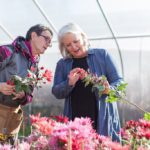
Ellen Paparozzi, Ph.D., of the University of Nebraska-Lincoln, teaches a wreath making class. She says her passion for floristry and horticulture is what makes her successful.
The Society of American Florists’ membership includes all segments of the industry — and that community is the heart of SAF. This bi-weekly feature will spotlight SAF members sharing inspirational stories, professional insights, and the opportunity to form new industry connections.
Ellen Paparozzi, Ph.D., grew up in a horticultural family. Her grandfather immigrated from Italy and grew grapes to make wine, and her grandmother had beautiful rose gardens. In fourth grade, Paparozzi’s teacher asked her what she wanted to study when she grew up. “I responded, ‘Floristry,’” she says. At 16, she began working at a local florist during summers and holidays. Paparozzi stayed at the shop for years and planned to continue her career there after university, but during her junior year at Cook’s College at Rutgers University she joined a scholar’s research project, which changed the course of her future.
She discovered her love of research and went on to graduate school at Cornell University. Upon graduating, the University of Nebraska was starting a horticulture program and invited her to be part of the team creating curricula from scratch and work on novel research areas.
Her favorite part of her job is the people, her colleagues, staff and students “from all over the world and many different walks of life, each building their own story.”
What She Takes Pride In
Paparozzi is most proud of three major projects that she’s worked on.
 The first is being part of the success of the University of Nebraska’s horticulture program, which includes starting a national horticulture honor society, Pi Alpha Xi. She measures their success by the fact that most of their students are gainfully employed as owners or managers of horticulture businesses. Her graduate students have also become successful industry and federal employees as well as university extension agents, professors, and administrators.
The first is being part of the success of the University of Nebraska’s horticulture program, which includes starting a national horticulture honor society, Pi Alpha Xi. She measures their success by the fact that most of their students are gainfully employed as owners or managers of horticulture businesses. Her graduate students have also become successful industry and federal employees as well as university extension agents, professors, and administrators.
The second is her research on sulfur deficiency, which made clear the importance of the balance between nitrogen and sulfur. “The result was that most fertilizers used to grow floriculture and ornamental crops now contain sulfur,” she says. “The presence of sulfur also allows for lower, more sustainable concentrations of nitrogen for good plant growth.”
And the third was the research she started with medicinal plants such as basil, and turning their leaves into essential oils.
Her Secret to Success
Paparozzi feels that her passion is what makes her successful.
“Growing and caring for plants every day, educating students from all over the world, creating floral bouquets, servicing funerals and weddings — all these activities require creativity, dedication, and long hours,” she says. “You must love what you do to be successful.”
Why SAF?
Paparozzi originally joined SAF because she was teaching the floral design course and wanted to keep an eye on the trends and costs in the industry. At the time, part of her course had a lab called “Designing for Dollars,” in which students had to create designs within a budget.
“When I was asked to teach floriculture and other plant physiology courses, I kept my membership to keep an eye on color trends and cultivars of flowers that were being used so I could keep my courses and my overall industry knowledge up to date,” she says.
Paparozzi was recently featured on SAF’s Facebook and Instagram accounts.
Do you know a member who should have a chance in the spotlight? Email Stephanie Brady, project manager for SAF.
Stephanie Brady is the project manager for the Society of American Florists.



